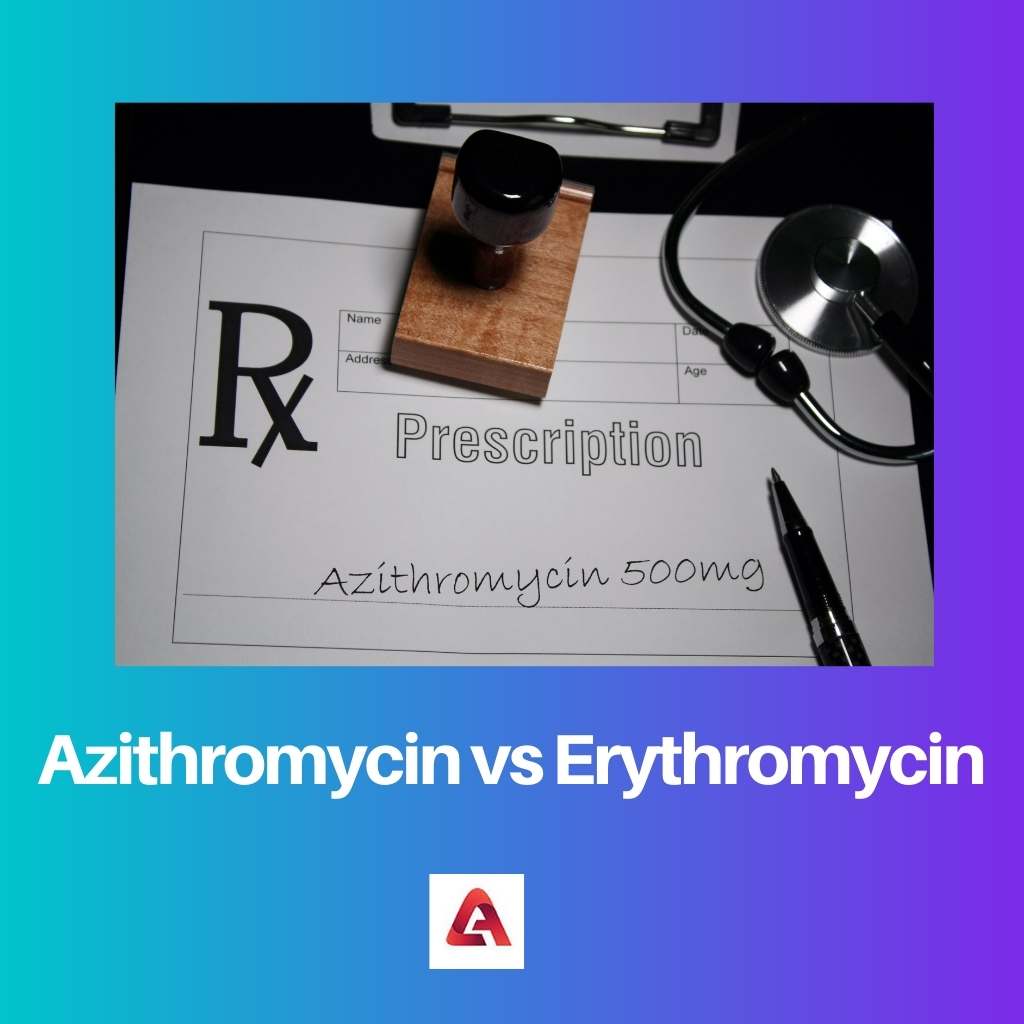Azithromycin and erythromycin are macrolide drugs used to treat soft tissue infections, upper and lower respiratory tract infections, and urinary tract and vaginal infections.
Azithromycin is a derivative of erythromycin. However, they are different in terms of mechanism and onset of action. There are several variables that may affect the drugs recommended by the doctor.
Key Takeaways
- Both azithromycin and erythromycin are antibiotics belonging to the macrolide class, used to treat various bacterial infections.
- Azithromycin has a longer half-life, allowing for less frequent dosing and a shorter treatment duration than erythromycin.
- Erythromycin is more likely to cause gastrointestinal side effects and drug interactions than azithromycin.
Azithromycin vs Erythromycin
The difference between Azithromycin and Erythromycin is that Azithromycin has a considerable half-life in the end. This might be due to the drug’s extremely wide absorption and release from the tissues.
Erythromycin is processed mostly in the liver of humans. It’s mostly excreted in the bile, though some of it also ends up in the urine. The half-life of erythromycin is roughly 1.5 hours.
Both of these antibiotics have the potential to interfere with the effectiveness of birth control tablets.

Azithromycin is a drug that aids in the treatment of bacterial infections in the body. They will eliminate the germs that are developing in the human body.
In recent years, it has been proven to be beneficial for the treatment of bacterial infections and is currently undergoing examination.
If you have a sore throat, you can take this medicine. It is mostly used to treat throat, nose, and lung infections.
Erythromycin is primarily used to treat infections caused by penicillin resistance. It offers more protection against infections of the upper respiratory tract.
Your doctor may prescribe erythromycin in the form of pills, slow-release capsules, ophthalmic solutions and ointments, gels, and other forms. Erythromycin’s specific method of action is unknown.
It is known, however, that it may have bactericidal properties. Azithromycin works by preventing germs from growing in the body. This is accomplished by interfering with their protein production.
Comparison Table
| Parameters of Comparison | Azithromycin | Erythromycin |
|---|---|---|
| Description | Zithromax (azithromycin) is a generic antibiotic that can be used to treat a variety of bacterial illnesses. It may, however, induce headaches, dizziness, or a rash. | Ery-Tab (Erythromycin) is an antibiotic that may be used to treat a range of bacterial infections. Before using it, check for medication interactions. |
| Treats | Treats bacterial infections. | Prevents and treats infections. |
| Half Life | 53 hours | 2 hours |
| Side effects | High | Low |
| Dosage form | Intravenous powder for injection Oral powder Oral tablet | Oral capsule Oral tablet Oral suspension |
What is Azithromycin?
Azithromycin is a kind of antibiotic. It’s commonly used to treat chest infections like pneumonia, throat infections, and sexually transmitted diseases.
Azithromycin is commonly used to treat ear infections and chest infections in children. It can also be administered for a long time to avoid chest infections in frequently infected patients.
The medication is available as capsules, pills, and a drinkable liquid on a prescription. It can also be given by injection, but this is done in a hospital setting.
Zithromax is another brand name for Azithromycin. Azithromycin is considered to be safe to use. However, nausea, vomiting, stomach discomfort, or diarrhoea are all possible adverse effects.
Long-term usage of the medicine may result in increased bacterial resistance in isolates and hearing loss. It has the potential to produce allergic responses, albeit these are uncommon.
As a result, Azithromycin is only available to people on prescription. It’s also used to treat pneumonia and diarrhoea caused by travel. Many doctors use it in combination with other malaria medications. It can be taken orally or injected directly into the veins.

What is Erythromycin?
Erythromycin is an antibiotic that is used to treat a wide range of bacterial illnesses. It may also be used to inhibit the spread of germs.
The antibiotic erythromycin belongs to the macrolide family of antibiotics. It works by preventing germs from growing. Only bacterial illnesses are treated or prevented with this antibiotic. It is ineffective against viral infections.
When an antibiotic is used when it isn’t needed, it loses its effectiveness for future illnesses. Adults, including pregnant and nursing mothers, can take erythromycin.
Children are able to take erythromycin. Certain persons should not take erythromycin. Nausea, vomiting, and stomach discomfort are all possible side effects of erythromycin.
As a result, the doctor may not recommend them as a first-line treatment, particularly Erythromycin. These drugs, such as urticaria and anaphylaxis, may cause adverse responses in patients.
Erythromycin is also used to prevent heart infections in persons who are having dentistry or other operations done.

Main Differences Between Azithromycin and Erythromycin
- Zithromax (Azithromycin) is a generic antibiotic that can be used to treat a variety of bacterial illnesses. It may, however, induce headaches, dizziness, or a rash, whereas Ery-Tab (Erythromycin) is an antibiotic that may be used to treat a range of bacterial infections. Before using it, check for medication interactions.
- Azithromycin treats bacterial infections, whereas Erythromycin prevents and treats infections.
- Azithromycin’s half-life is 53 hours, whereas Erythromycin’s is 2 hours.
- Azithromycin has a higher frequency of side effects than Erythromycin, whereas Erythromycin has fewer side effects.
- The azithromycin dosage form is Intravenous powder for injection, oral powder for reconstitution, and Oral tablet, whereas the Erythromycin dosage form is an Oral capsule, Oral tablet, and Oral suspension.





